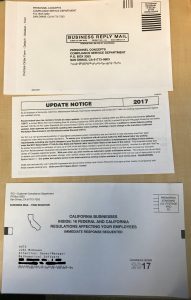Inside the Growing Guest Worker Program Trapping Indian Students in Virtual Servitude
An article in the left-wing Mother Jones magazine on Indian students and the OPT program, using students at the University of Central Missouri as examples.
STEM Worker High Turnover Rates
http://www.businessinsider.com/employee-retention-rate-top-tech-companies-2017-8
An article in Business Insider on the possible high turnover rate of many tech companies. It does not clearly separate the turnover rate and average duration of employment at a company. A company that is growing rapidly can have a low turnover rate and a low average duration of employment simply because so many employees are new. If a company doubles in size in two years, half its’ employees will have no more than two years of employment at the company.
Apple, for example, has been growing and hiring rapidly the last several years. Many employees are new which will pull down the average employment time. Having worked at Apple from 2014-2016, I suspect it does have a high turnover rate but it is hard to prove due to the apparent rapid growth of the company.
Alleged Age Discrimination in STEM
http://www.bbc.com/future/story/20170828-the-amazing-fertility-of-the-older-mind
An article from the BBC on the considerable ability of older people to learn new things contrary to a common stereotype.
https://www.computerworld.com/article/3090087/it-careers/google-age-discrimination-lawsuit-may-become-monster.html
An article by Patrick Thibodeau at Computerworld on the Google age discrimination class action lawsuit.
Race and Sex Discrimination in STEM
https://www.theguardian.com/technology/2017/aug/07/silicon-valley-google-diversity-black-women-workers
An article in The Guardian questioning Google and other Silicon Valley employer explanations for the low numbers of some groups in their companies, pointing to the large number and percentage of African Americans employees in software engineering in the Washington DC area — generally at government agencies such as NASA and government contractors.
It should be noted that the DC metro area is about 25 percent African-American whereas California as a whole is about 6.5 percent African-American. Of course, as the article points out, Google and many other tech companies recruit worldwide.
However, Hispanics with visible American Indian ancestry almost certainly make up over 30 percent of California and the San Francisco Bay Area’s population, a comparable or even larger fraction than African-Americans in the DC metro area. The US Census claims that 38.9 percent of people in California in 2016 were Hispanic-Latino. Probably 80 to 90 percent of these have visible American Indian ancestry.
The US Census relies on self-identification for race rather than visible appearance. Hispanics self-identify as white, mixed race, “other race,” and sometimes American Indian/Native American. My personal impression is that genuine discrimination tends to follow visible appearance and accent/spoken dialect of English.
Hispanic is not a racial category, including people who are entirely European and indeed Northern European in appearance. At least in my personal experience, most — not all — Hispanics in leadership and engineering positions at high tech companies like Google are European in appearance. On its diversity web site, Google claims that 4 percent of its workforce in 2017 are Hispanic.
UPDATE (added September 11, 2017)
“At Google, Employee-Led Effort Finds Men Are Paid More Than Women,” by Daisuke Wakabayashi, New York Times, September 8, 2017
The article discusses an internal Google spreadsheet set up by a now former Google employee with self-reported salary and bonus information from Google employees showing women paid less than men. There is also discussion of the current Labor Department investigation into disparities in salaries between men and women at Google as well as activist investors pressuring Google to disclose information on the salaries of men and women at Google.
Articles Questioning STEM Shortage Claims
http://www.techrepublic.com/article/so-much-for-the-stem-shortage/
Tech industry’s persistent claim of worker shortage may be phony, by Michael Hiltzik, Los Angeles Times, August 1, 2015
An article noting the obvious inconsistency between the many layoff announcements in high tech and the claims of a shortage of STEM workers, often by the same employers.
The Open Office Nightmare
Apple staffers reportedly rebelling against open office plan at new $5 billion HQ
An article claiming discontent over the new open office plans at Apple’s new headquarters — the “Spaceship” — in Cupertino.
(C) 2017 John F. McGowan, Ph.D.
About the author
John F. McGowan, Ph.D. solves problems using mathematics and mathematical software, including developing gesture recognition for touch devices, video compression and speech recognition technologies. He has extensive experience developing software in C, C++, MATLAB, Python, Visual Basic and many other programming languages. He has been a Visiting Scholar at HP Labs developing computer vision algorithms and software for mobile devices. He has worked as a contractor at NASA Ames Research Center involved in the research and development of image and video processing algorithms and technology. He has published articles on the origin and evolution of life, the exploration of Mars (anticipating the discovery of methane on Mars), and cheap access to space. He has a Ph.D. in physics from the University of Illinois at Urbana-Champaign and a B.S. in physics from the California Institute of Technology (Caltech).







